14 Reasons Why Your Email Goes To Spam & How To Fix It
Why do my emails go to spam?
If you have ever delivered an email only to have it landed in the recipient’s spam folder, you might find yourself yelling at your screen from time to time.
We understand it is a frustrating situation.
You sent an important message, but your recipients probably can’t see it because, to be honest, how often do people actually check their spam folders?
So, in this blog post, we will reveal 14 reasons why your emails end up in spam. Besides, we will also share 4 practical solutions to ensure your emails get to recipients’ inboxes.
Let’s get going!
Why does my email go to spam?
1. You didn’t get permission from recipients
The first and foremost rule of email marketing is to always get permission before sending an email.
You should never purchase a list of emails or obtain them via any other unscrupulous means. It is unethical, ineffective, and even potentially lands you in some hot legal water.

Online privacy laws, such as the GDPR, require that you have express permission from recipients to send them emails. That means you cannot simply buy email lists to get quick access to a bunch of contacts.
Also, it means that even visitors who provide their email addresses on your website need to explicitly tell you that they actually want to receive emails from you, especially if they are a citizen of the EU. This often comes in the form of a checkbox that visitors need to tick to indicate their willingness or a disclaimer during account creation.
While this is not necessarily required in the US, it is still a good practice. People receive many emails these days, and if your messages suddenly appear in their inbox when they didn’t ask for them, chances are they may be marked as spam.
2. You haven’t set up proper authentication
One of the biggest problems with email spam is lacking proper authentication.
Think of when someone calls you on the phone:
- If it’s someone from your contacts, you will pick right up because you know exactly who is calling
- If it’s a random number, you might assume it is another robocall and just ignore it.
The situation is the same with emails. Some technologies can be used to authenticate your emails and automatically make you look more trustworthy in the eyes of spam filters. Rather than a random number, you have proven who you are and that you control the domain name that you are sending from.
The main types of email authentication include:
- DKIM (DomainKeys Identified Mail) - provides an encryption key and digital signature to verify an email.
- SPF (Sender Policy Framework) - verifies the IP (Internet Protocol) address of the sender against a list of approved IPs
- DMARC - requires you to be already using DKIM and SPF
If you are using a custom email address and haven’t set up these authentication methods, that can be the reason why your emails are going to spam.
3. Your sender information is missing or incorrect
Here’s what the FTC (Federal Trade Commission) says about the sender information:
“Your ‘From,’ ‘To,’ ‘Reply-To,’ and routing information, including the originating domain name and domain name and email address, must be accurate and identify the person/ business who initiated the message.”
In short, you must clearly state who you are (or who your business is) and not include any incorrect information that could mislead someone.
For instance, the sender information on my email might say “Haley from AVADA Commerce.”
4. You’re sending your emails to inactive addresses
We think you’ve seen a message like this at some point.
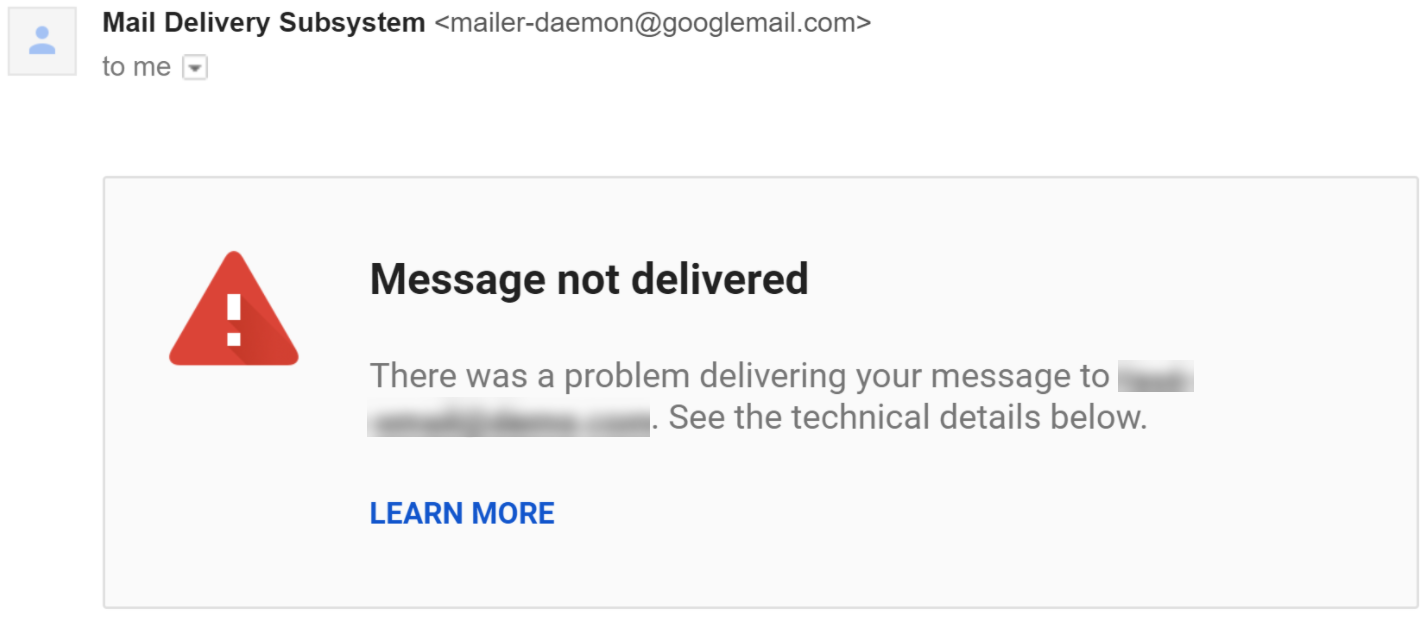
That means your email was sent to an inactive address and thus not delivered. If you send bulk emails and consistently send emails to inactive email addresses, spam filters will penalize your domain or ISP (Internet Service Provider).
That’s why you should continually clean your email list and delete inactive addresses.
5. You’re using spam trigger words
Simply put, some words seem spammy.
Keep in mind that email spam filters always look at your email content to decide whether it ends in the spam folder of your recipient’s inbox. Saying things like “You’re a winner!” or “Double your income!” is a surefire way to get unwanted attention from those filters.
If they notice suspicious “trigger words,” it is a red flag, and your email is likely to be sent to spam even if you have the best of intentions.
6. Your email headline is weak
Besides the sender’s name, your email headline helps recipients decide whether it is legit or not and whether they should open it.
Studies show that up to 69% of recipients report email spam based solely on the subject line. Hence, you need to nail it.
In addition to steering clear of trigger words, there are several other subject line best practices you will want to follow to keep your messages out of the spam abyss. These include:
- Not using excessive capital letters, as this seems like you are shouting at recipients
- Not making false promises
- Not going overboard with exclamation points
- Not sounding overly pushy or salesy
When it comes to crafting an email headline, we recommend putting yourself in your recipient’s shoes.
Is there any way that people might think your email is spam based on the headline? If yes, tweak it until it is presentable.
Related topic: 101 Killing Email Headline Examples
7. You have incorrect spelling and grammar
Researchers realize the surprising frequency of spelling and grammatical errors in phishing emails. This often happens because non-native English-speaking hackers use translating tools to convert their text into English.
Therefore, spam filters are on high alert, and incorrect spelling and grammar could land your email in the spam folder.
Not to mention, you are going to look unprofessional in the eyes of your audience. So, you should be extra diligent about double and even triple-checking every email before sending it out.
8. You don’t include a physical address
This may surprise some email marketers.
But the FTC requires that you include your valid physical address. That can be one of the following:
- your current street address
- a post office box you have registered with the US Postal Service
- a private mailbox you have registered with a commercial mail receiving agency established under Postal Service regulations
Otherwise, you are not following their requirements, and your emails could be marked as spam. You will notice that most businesses add their physical address toward the bottom of their email.
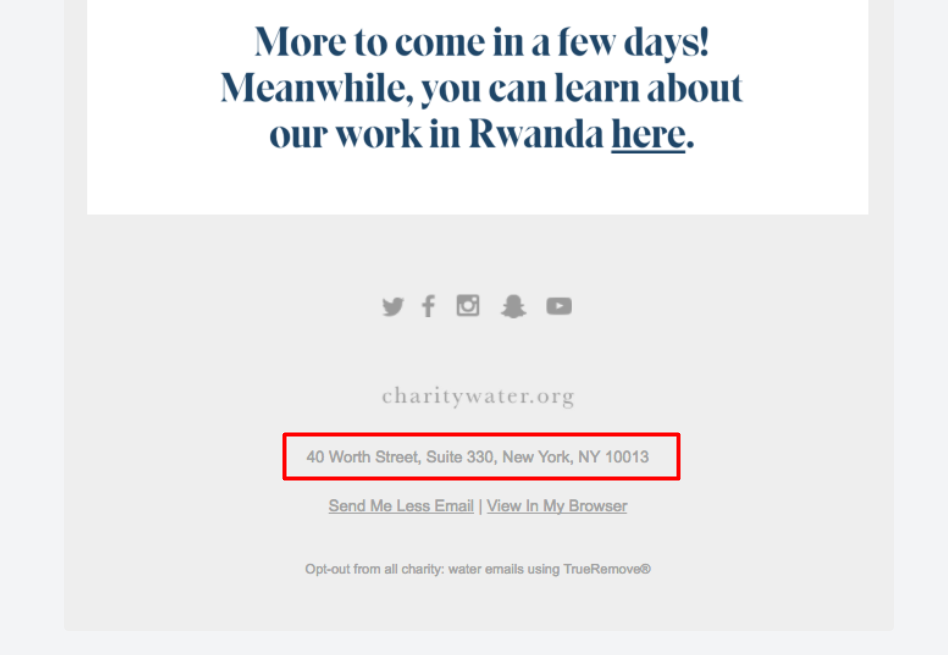
9. You’re using too many images with minimal text
Images can actually get you into trouble with spam filters.
There are two common ways that this can happen.
Firstly, if you include only one large image with little to no text in your email, that can trigger spam filters. In fact, to avoid getting hit with spam filters for including spammy words, some people move to include all of the text in a single image file, rather than as actual text. Due to this, sending only one image looks suspicious to spam filters.
Secondly, if you include a lot of images and very minimal text, that can also get you into trouble.
In short, using images as a replacement for your text can land your email in spam, don’t do that!
10. You’re not following HTML best practices
Below is an example of a text-only email from MealPal.
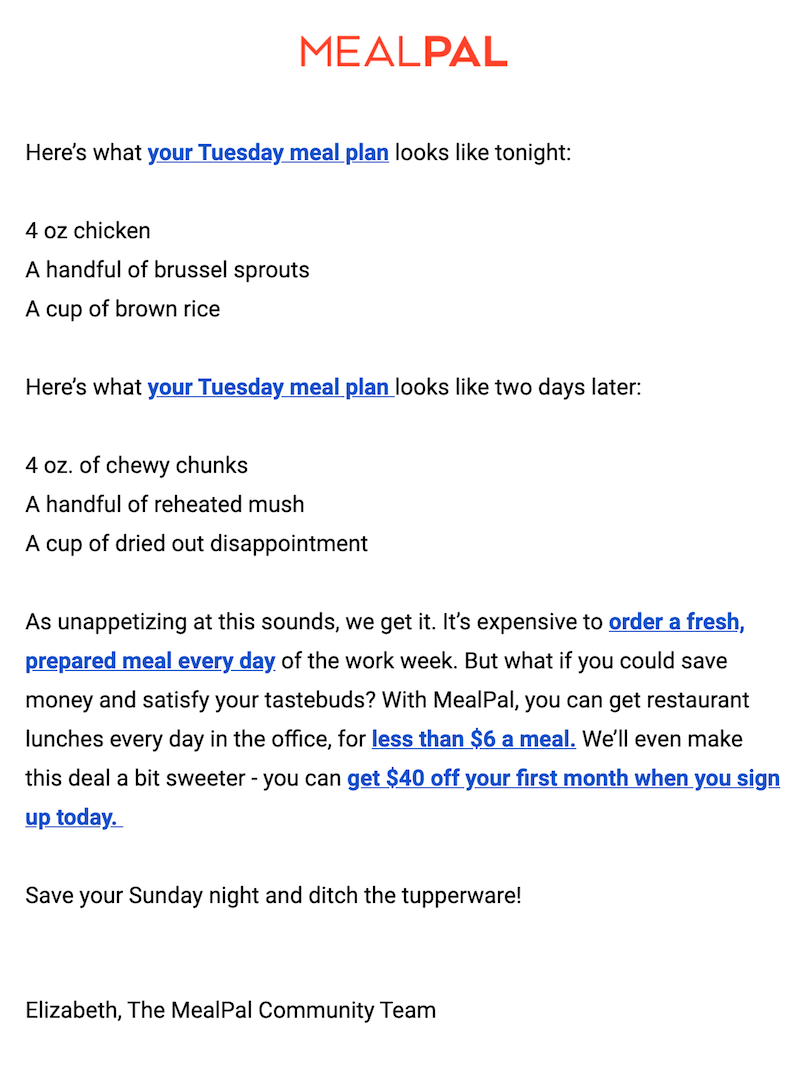
As you can see, while text-only emails are straightforward, they might not be a viable option for E-commerce businesses, because they may lead to lower engagement when compared to emails with images, branding, and other HTML elements.
Nevertheless, when including HTML in your emails, it is essential to follow some simple rules to be sure that they don’t end up in the spam folder.
Here are a few HTML best practices for email:
-
Keep the maximum width of your email from 600 to 800 pixels. This makes sure that it is large enough to read easily, while behaving well in email client preview panes.
-
Keep your code as light and clean as possible, particularly CSS. Additionally, avoid Flash and JavaScript entirely, as they may be seen as vectors for attack by spam filters, and some email clients don’t support them anyway.
-
Assume that any images can be blocked by email clients and that recipients may not see essential information if it is contained within media elements.
-
Ensure your emails are mobile-friendly. That means thumb-friendly buttons, email safe fonts that are readable on small screens, and small images that won’t overload mobile networks.
-
It is a good idea to make most of your email’s content text, as well as minimize the amount of HTML you include. Your company branding and perhaps a pop of color can do wonders for engagement, without going overboard.
11. You’re sending too many attachments
Don’t send attachments unless they are absolutely necessary.
Firstly, they alert spam filters and lower the chances of your message making it to the recipient’s inbox. An attachment could also carry some hardcore virus, which is just waiting to overtake an unsuspecting victim’s device.
Secondly, attachments can slow down the loading time of your email, especially if they are big and bulky.
Generally speaking, there is no need to send a commercial email with an attachment.
12. You’re using misleading links or linking to shady websites
The primary purpose of most spam emails is to have you click on some type of link. Therefore, it comes as no surprise that using the wrong types of links will get you in trouble.
There are often two main things that cause issues here:
Firstly, you might be linking to a site that seems spammy for some reason. It is maybe associated with copyright infringement, infected with malware, etc. Or, it is maybe totally legit, but it is very close to another spammy domain.
Secondly, you can get into trouble if the destination URL doesn’t match the display URL. For instance, the display URL is https://avada.io, but the actual link is https://anotherwebsite.com. This common trick is used by spammers to get people to click links.
13. You don’t include an unsubscribe link
Have you ever found yourself in this situation: You didn’t want to receive any more emails from a particular brand, but there was no way to unsubscribe.
It’s super irritating.
Best-case scenario, you annoy recipients or wind up in the spam folder.
Worst-case scenario, you get fined by the FTC.
Either way, it is a lose-lose situation.
Therefore, it is vital (not to mention legally required) to include an unsubscribe link like this one in your email.
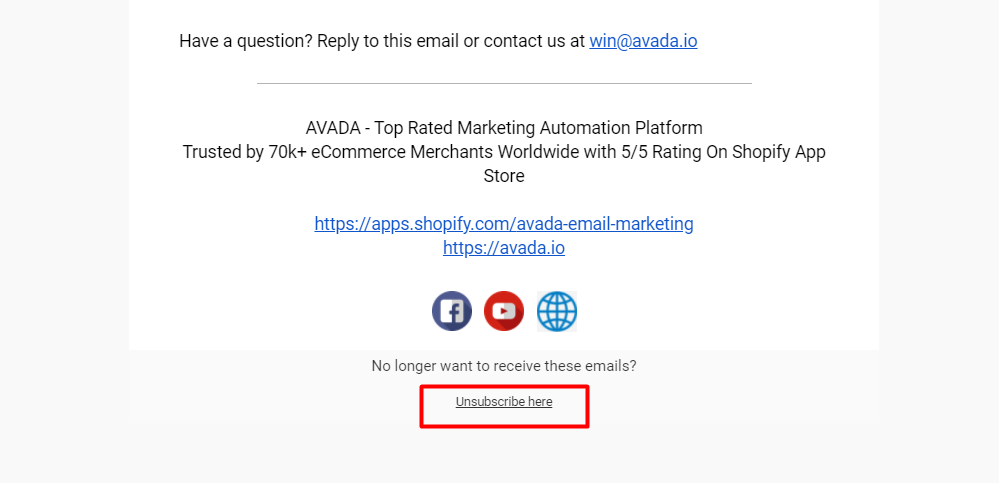
14. Recipients marked you as spam (maybe accidentally)
In some email clients, users have an option to mark emails as spam manually.
If your recipients marked your emails as spam, new emails that you send would likely go to spam as well.
In addition, if you are sending out bulk emails, too many recipients marking your emails as spam can negatively affect your sender reputation. Consequently, this can increase the chances of your emails landing in spam even when you send to people who did not mark you as spam.
4 solutions to avoid the spam folder
As you know what might be going wrong, let’s learn some actionable solutions to keep your emails out of the spam filter.
Follow email design/ copy best practices
-
Avoid spammy copy. Don’t use spammy words, don’t abuse punctuation/ emojis, and avoid spelling/ grammar issues.
-
Don’t abuse images. Don’t use only one large image or a lot of small images. Use text/ HTML rather than include everything in images.
-
Avoid unnecessary attachments. Don’t include attachments unless they are absolutely necessary.
-
Ensure to add sender information. For marketing emails, ensure to include your sender information and physical address.
-
Only link to reputable sites. Don’t do anything that could be considered “tricking” people to click links they didn’t intend to visit.
Regularly maintain your subscriber lists
If you are sending emails to a lot of subscribers, you will also want to:
- Ensure your subscribers explicitly opt-in
- Regularly clean your list of unengaged/ inactive accounts
- Give subscribers a clear, straightforward option to unsubscribe
Ask recipients to whitelist your emails
You can ask recipients to whitelist your emails to avoid them going to spam. Even big brands ask their subscribers to whitelist their emails, so this is actually a common strategy.
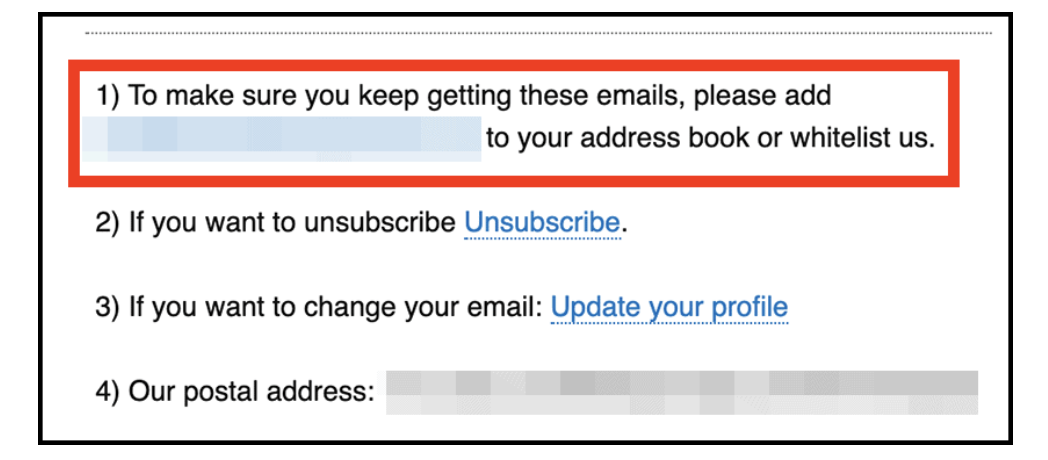
To make it much easier for people, you can create a help doc to show them how to whitelist your email in popular email clients, like Gmail.
Consider using spam checkers
If you follow all of the above solutions, and still have a problem with your emails getting sent to spam, below are some spam checkers that you can use to test your emails for issues.
Mail Tester
This is a free spam checking tool, giving you an easy-to-understand and straightforward score out of 10 on a scale of spamminess.
You will need to check each email manually, but it checks to see if you are blacklisted, DKIM, as well as the quality of your message.
Litmus
Litmus is a comprehensive suite of email optimization tools that includes a spam checker. Litmus helps you:
-
Scan your messages by all the major spam filters before you send in order to ensure that they pass
-
Check your reputation by investigating your IP addresses and any domain name used in your email, as well as checking them against known blacklists
-
Verify that your email authentication, such as DomainKeys, SenderID, DKIM, and Sender Policy Framework, is correctly set up
-
Give you a spam score that explains why you got that score and how to improve it
IsNotSpam.com
With this free spam checker, you will have to check each email manually, and it does not have a comprehensive testing capability. However, it will check your SenderID, Sender Policy Framework, and DKIM to ensure they’re set up properly. Besides, it’ll do a SpamAssassin check to score your email content.
The bottom line
That’s it!
In this guide, we’ve helped you in 2 key ways:
- Identify 14 reasons why your emails may be landing in spam
- Give you 4 concrete solutions to get back in your subscribers’ inbox
Now, it’s your turn!
If you still have any questions about why your emails go to spam, please let us know! And don’t forget that AVADA Commerce is always willing to help you reach recipients’ primary inboxes.
New Posts






